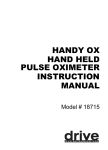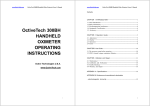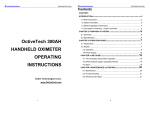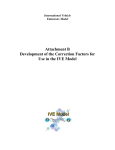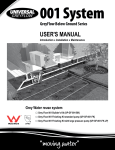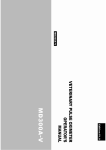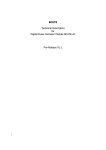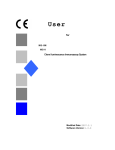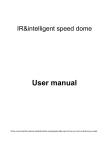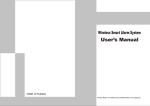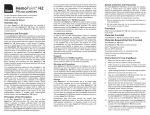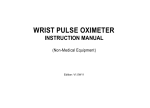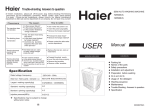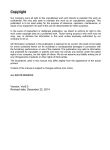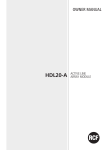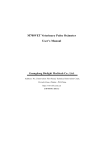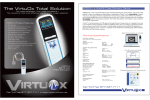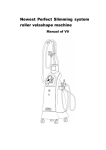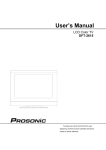Download Untitled
Transcript
Contents CHAPTER 1 INTRODUCTION……………………………2 1.1 Brief Introduction……………………………………………….2 1.2 Safety Information……………………………………………2 1.3 Electromagnetism Interference………………………………5 1.4 Equipment Classification……………………………………5 1.5 Accessory……………………………………………………5 CHAPTER 2 General Descriptions ……………………….....6 2.1 Front panel………………………………………………6 2.2 Rear panel……………………………………………………7 2.3 Product feature…………………………………………………8 2.4 Scope application……………………………………………8 CHAPTER3 Install the batteries and the sensor………….....8 CHAPTER 4 ID, Date and time Setting…………………10 CHAPTER 5 Take a measurement……………………………10 CHAPTER 6 History Data reviewing……………………........13 CHAPTER 7 ID setting……………………………...................14 VER.1.3 PULSE OXIMETER OPERATOR'S MANUAL CHAPTER 8 Alarm setting…………………………….............14 CHAPTER 9 Beep on/off………………………………………18 CHAPTER 10 Maintain and repair……………………………18 APPENDIX A: Specifications…………………………23 APPENDIX B: Guidance and manufacture's declaration - electromagnetic immunity……………………….24 1 VER.1.3 PULSE OXIMETER OPERATOR' S MANUAL 1 INTRODUCTION 1.1 Brief Introduction Thank you for using the handheld pulse oximeter. The main function of the device is to measure SPO2 and PR, visual and audio alarm, sensor off alarm, data storage and replay etc. Please read the operator's manual carefully before using it. 1.2 Safety Information Conception of Warning, Precaution and Notice The Warning, precaution and Notice at this document are special information in favor of users operation. ★ Warning Indicate that maybe some potential hurt or damage to patients. ★ Precaution Make user must take a serious attitude to the incorrect operation, which are likely to incur some life-threatening incidents. ★ Notice Serve as a pivotal notice to avoid preventable incidents during application of this equipment. Warnings z The handheld pulse oximeter should be confined to sophisticated operator exclusively. Prior to application, we strongly suggest you should follow instructions listed in this document, or any wrong-doing operation which causes serious damage will take full responsibility for this. Our company will assume no warranty for using this equipment improperly. z Do not close to liable flammable matters, spark in case of unexpected explosion. z Do not apply this equipment at such environment as magnetic resonance imaging (MR or MRI) equipment which is the source of some electric noise to influence the accuracy of this equipment and following treatment. z Make sure to apply this equipment for medial sphere, and gauging results only serve as a reference for any relevant treatment. z Please cautiously use this equipment for too long time, It is necessary for you to protect yourself from avoidable injury. 2 VER.1.3 PULSE OXIMETER OPERATOR' S MANUAL z When placing sensor in right place, please see to it that strict work instructions must be due, for example do not extend tape or fix it too tightly. z When begin to gauge associated body features please follow the doctor’s counseling. z When connecting this equipment to any instrument, verify proper operation before clinical use. Refer to the other device’s manual for full instruments. Accessory equipment connected to the oximeter’s data interface must be certified according to IEC Standard 950 for data-processing equipment or IEC Standard 601-1 for electromedical equipment. All combinations of equipment must be in compliance with IEC Standard 601-1-1 system’s requirements. Anyone who connects additional equipment to the signal input port or signal output port configures a medical system and is therefore responsible that the system complies with the requirements of system standard IEC Standard 601-1-1. z Considering the sensor is a sensitive device so please strictly follow the sensor application instructions. z The malfunction of sensor may cause inaccurate data which serve as a foundation to treat patients, so make pay more attention to the sensor and inspect it more usually. z The worn-out data cables may cause inaccurate data and used as a reference to treat patient, so must pay attention to data cable and check it more frequently. z The disposable peripheral should not be cycled. Precautions z Rinsing the sensors with ethylene oxide solution may have adverse influence on the machine, Apart from this, should not autoclave or submerge the sensor. z This device is intended for use by persons trained in professional health care. The operator must be thoroughly familiar with the information in this manual before using the device. z Unplug the sensor from the monitor before cleaning or disinfecting to prevent sensor or monitor from being damaged, and to prevent user under safety situation. z Alarm must be set up according to different situation of individual patient. Make sure that chime sound can be activated when alarm 3 VER.1.3 function begin to work. PULSE OXIMETER OPERATOR' S MANUAL Notices z Application of this device may influence the measuring accuracy in the background of electromagnetic areas such as electro-surgery environment. z Operation of this device may be adversely affected in the presence of computed tomography (CT) equipment. Use only BCI SpO2 sensors supplied with, or specifically intended for use with, this BCI device. Use of sensors not intended for use with this device may cause inaccurate readings. Pay more attention to the application when apply this device under the situation of computed tomography (CT) environment. Please exclusively use the attached accessory, BCI SPO2, z SpO2 measurements may be adversely affected in the presence of high ambient light. Shield the sensor area (with a surgical towel, for example) if necessary. z Dyes introduced into the bloodstream, such as methylene blue, indocyanine green, indigo carmine, and fluorescein, may adversely affect the accuracy of the SpO2 reading. z Any condition that restricts blood flow, such as use of a blood pressure cuff or extremes in systemic vascular resistance, may cause a failure to determine accurate pulse rate and SpO2 readings. z Remove fingernail polish or artificial fingernails before applying SpO2 sensors. Fingernail polish or artificial fingernails may lead to inaccurate SpO2 readings. z SpO2 averaging is the number of pulse beats over which the SpO2 value is averaged; pulse averaging is the number of seconds over which the pulse value is averaged. z Hazards arising from software errors have been minimized. Hazard analysis conforms to meet ISO14971: 2000 and EN60601-1-4: 1996. Significant levels of dysfunctional hemoglogins, such as carboxyhemoglogin or methhemoglobin, will spawn an affection of the accuracy of the SpO2 measurement. z Optical cross-talk can occur when two or more sensors are located in adjoining area. It can be eliminated by covering each site with opaque material. Optical cross-talk may adversely affect the accuracy of the SpO2 readings. 4 VER.1.3 PULSE OXIMETER OPERATOR' S MANUAL z Obstructions or dirt on the sensor’s red light or detector may cause a sensor failure. Make sure there are no obstructions and the sensor is clean. z For routine equipment maintenance, please refer to the service procedures at the associated section as indicated in the manual. z As to the other concerns for attention, please carefully look through the specific chapter in this instruction. 1.3 Electromagnetism interference This oximeter is designed and tested in compliance with the EMC standard, complying with the international standard for the EMC of the electronic medical device - IEC 60601-1-2. However, because of the proliferation of radio frequency transmitting equipment and other sources of electrical noise in the health-care and home environments (e.g. cellular phones, mobile two-way radios, electrical appliances) it is possible that high levels of such interference due to close proximity or strength of a source, may result in disruption of performance of this device. This apparatus complies with the IEC 60601-1-2 international standard. The requirements of this international standard are: CISPR11, GROP1, and CLASS B 1.4 Equipment classification 1.5 Accessory 1. Two AA batteries 2. One operator’s manual 5 VER.1.3 PULSE OXIMETER OPERATOR' S MANUAL 3. One adult finger sensor: compatible with BCI Optional accessory: 1. Finger sensor for pediatric and infant: compatible with BCI (Pediatric 15-45 Kg, Infant 3-15 Kg) 2. Finger sensor for neonate: compatible with BCI (Neonate<3kg) 3. Data cable 4. Software for data transmission. 2 General Descriptions The handheld pulse oximeter adapts 8-segment digital LED as indication. It can display the SPO2 and pulse rate value, all kinds of parameters, such as time & date, ID number, as well as pulse bar battery status etc. 2.1 Front panel: Please refer to Fig 1. The figure is initial display mode. Fig1Front panel 6 VER.1.3 PULSE OXIMETER OPERATOR' S MANUAL Instruction of figure 1: □1 SPO2:SPO2 value(displaying value is 98% now) □2 PR:Pulse rate(displaying value is 76 bpm now) :Low power indication. When the power is lower than 2.4V, this □3 sign will be lighted. And the oximeter will power off automatically when the power is lower than 2.3V. □4 Alarm Indication: When technical alarm or physiological alarm occurs, the light on the sign will turn red. □5 Power on button □6 Navigation buttons: you can select and set the different parameters. key: press the up key, the unit will display the ID □ Shortcut key: number. key: press the right key, the unit will display the Error number. □7 Menu button: You can return to the measurement picture or switch the main menu item by this button. □8 Reserved function. Beep off/on Indication: When beep voice off, the LED on. □9 □10 Alarm light: When there is an alarm or indication, the relative light on the sign will be light. □11 Pulse bar:The pulse bar is proportion to the Pulse volume. Note: According to the customs orders, not all the pulse oximeter with all the functions listed above. 2.2 Rear panel 7 VER.1.3 PULSE OXIMETER OPERATOR' S MANUAL Fig.2 Rear panel introduction: 1: Battery box 2: Fixing hole 3: Battery box cover 4: Fixing screw 2.3 Product features: Rubber grip design offers special protection Compact, lightweight design for simple, one-hand operation High brightness LED display SpO2, pulse rate and pulse bar. Up to 100 patients’ ID and 72-hour record storage Visual & audio alarm, low battery alarm Data transfer to PC for storage or printing Convenient 2 AA size alkaline batteries Suitable for adult, pediatric and neonatal patient 2.4 Scope application: The purpose and function of the handheld pulse oximeter is to spot check or monitor %SpO2 and pulse rate for adults, pediatric and neonate patients in all hospital areas. It can help the doctor and nurse know the patient’s %SpO2 and pulse rate rapidly, and stored the 72 hours data. 8 VER.1.3 PULSE OXIMETER OPERATOR' S MANUAL 3 Install the batteries and the sensor 3.1 Install the batteries as the following pictures: 1)Open the battery cover: Rotate the fixing screw slightly in the rear panel to the upright position which is marked with “ ” and then open the cover with nail. Fig.3 2) Install two batteries lightly as indicated by the polarity sign:(refer to Picture 4) Note: Make sure the polarity of the batteries is correct 3) Close battery cover Close the battery cover and rotate the screw to the position. And the battery is locked. Fig. 4 Make sure that the polarity of the batteries is correct. Otherwise the unit cannot operate normally. Battery life and replacement When the low power indication light please replace the batteries with new ones timely. Always turn the unit off before replacing the batteries. Dispose of the used batteries according to the applicable local regulations. 9 VER.1.3 PULSE OXIMETER OPERATOR' S MANUAL Warnings! If battery fluid should get in your eyes, immediately rinse with plenty of clean water. Consult a doctor immediately. Caution! Do not use batteries not specified for this unit. Do not insert the batteries with the polarities in the wrong direction. Do not dispose of batteries in fire. If battery fluid should get on your skin or clothing, immediately rinse with plenty of clean water. Remove the batteries from this unit when you are not going to use it for a long period of time (approximately three month or more). Do not use batteries of a different type together. Do not use new and used batteries together. 3.2 Install the sensor as the following pictures: Fig.5 Insert the SpO2 sensor to the socket. 4 Setting ID, Date and time Always set the date and time before using the unit for the first time. Set different ID number for different user. Check the date and time are correct before using the unit, reset them if necessary. The date and time are important indicators when a measurement is taken. 10 VER.1.3 PULSE OXIMETER OPERATOR' S MANUAL 4.1 Date & Time Setting Press the menu key three times under the interface of initial display mode to enter time setup, and then press the left or the right button to select different data & time parameters, parameter will be displayed in the following order. : It means the minute. The setting range is: 0-59 : It means the hour. The setting range is: 0-23 : It means the date. The setting range is: 1-31 : It means the month. The setting range is: 1-12 : It means the year. The setting range is: 0-20 Press up or down key to your suitable value. Minute setting for example: 1) Press the power button to turn on the unit. 2) Press the menu button for four times to enter into the time setting picture shown as fig.6: press the up or down button to set the suitable year, and then press the left or the right button to enter into the other date and time parameters setting pictures. 4.2 ID number Setting In initial display mode press up key, the number LED shows ID number, after 3 seconds, it will back to initial display mode automatically. After power on, press the menu button for two times you can enter into the ID setting picture. Fig. 7 Press the up or down button to set the ID number and then press the menu button to confirm your selection and enter into other parameter setting picture. It will turn to the normal measuring picture if there is no button pressed for one minute. The setting range of ID number is: 0-127 11 VER.1.3 PULSE OXIMETER OPERATOR' S MANUAL 5 Take a measurement After finishing the time and the ID number setting, plug your finger into the sensor shown as the following picture: Fig 8 placement of the sensor z Select the suitable sensor in terms of type and dimension. z Clip the sensor to the rational position of the patient finger z Plug sensor into SpO2 port on top panel of pulse oximeter. Description of Fig.9: SPO2: SPO2 value ( displaying value is 98% now) PR:Pulse rate(displaying value is 67 bpm now) Fig.9 Warnings! z The measurement would not be performed if the following instances come across in operation: z Shock z Low temperature of hand z Have taken vascular activity medicine z Anemia z carboxyhemoglobin z methemoglobin z methylene blue z Indigo carmine 12 VER.1.3 PULSE OXIMETER OPERATOR' S MANUAL z Use only SPO2 sensors provided by manufacturer for SPO2 measurements. Other SPO2 sensors may cause improper performance. z Do not use an SPO2 sensor with exposed optical components. z Excessive patient movement may cause inaccurate measurements. z Tissue damage can be caused by incorrect application or use of sensor, for example by wrapping the sensor too tightly. Inspect the sensor site to ensure skin integrity and correct positioning and adhesion of the sensor. More frequently inspection should be taken depend on different patients if necessary. z Set the upper limit of SPO2 alarm to 100% means cut off the upper alarm. High density of oxygen will cause adverse affection to the neonate .So the upper limit of SPO2 alarm must be selected prudently according to the acknowledge clinical practice. z Inaccurate measurements may be caused by: z Incorrect sensor application or use z Significant levels of dysfunctional hemoglobins (such as c arboxyhemoglobin or methemoglobin) z Intravascular dyes such as indocyanine green or methylene blue z Exposure to excessive illumination, such as surgical lamps (especially ones with a xenon light source), bilirubin lamps, fluorescent lights, infrared heating lamps, or direct sunlight z High-frequency electro surgical interference and defibrillators z Venous pulsations z Placement of a sensor on an extremity with a blood pressure cuff, arterial catheter, or intravascular line z The patient has hypotension, severe vasoconstriction, severe anemia, or hypothermia z There is arterial occlusion proximal to the sensor z The patient is in cardiac arrest or is in shock z Loss of pulse signal can occur in any of the following situations: z The sensor is too tight z There is excessive illumination from light sources such as a surgical lamp, a bilirubin lamp, or sunlight z A blood pressure cuff is inflated on the same extremity as the one to which an SPO2 sensor is attached 13 VER.1.3 PULSE OXIMETER OPERATOR' S MANUAL Note:Pulse sensor should obviate the light source, e.g. radial lamp or infrared lamp. 6 History Data reviewing 6.1 Character Definition: : The user’s SpO2. : The user’s pulse rate. : The user’s ID number. : The minute of the history data. : The hour of the history data. : The date of the history data. : The month of the history data. : The year of the history data. 6.2 Reviewing operation: In the measuring picture press the menu button for one time you can enter into the data reviewing picture shown as the Fig 10. And then press the up or down button, you can review the last user’s SpO2, PR, ID and the minute, hour, data, month and year of measuring. The measuring data is recorded every four seconds, so press the right or left button, you can get the data of other four seconds. Fig.10 7 ID setting Please refer to the “4 Setting ID, Date and time” CAUSION: If user wants to save the measurement value, should setup the ID number first. WARNING! z If user wants to save the history measurement value, should setup ID number first. z The ID number is from 0-127, If change a patient, user should setup a new ID number to part the last patient 14 VER.1.3 PULSE OXIMETER OPERATOR' S MANUAL 8 Alarm setting 8.1 ALARM PRIORITY There are there-level priorities for selection. High priority: the highest level alarm, indicate the patient is in the very dangerous situation. Medium priority: indicate the warning should be paid attention. Low priority: indicate the measuring value beyond the preset limitation. Alarm of this oximeter includes technical and physiological alarm. All three priorities divided by built-in module and can not be changed by user. VISUAL ALARM INDICATORS: If the alarm is activated through over limitation of physiological alarm, corresponding data area is flashing. If the alarm is activated by more than one physiological alarm, each parameter will be displayed with flashing. AUDIBLE ALARM INDICATORS: Audible alarms can be heard if there is no silence. The audible alarm has different tone pitch and on-off beep patterns for each alarm priority. High priority: "du-du-du-------------du-du”, beeps every 8 seconds. Medium priority: "du-du-du", beeps every 5 seconds. Low priority: "du-”, beeps every 5 seconds. 8.2Character Definition: : High alarm of SpO2 : Low alarm of SpO2 : High alarm of pulse rate : Low alarm of pulse rate : Turn on or turn off the Alarm 8.3 SpO2 alarm setting: SpO2 high alarm: Turn on the oximeter and press the menu button for three times, and you will enter into the following picture of high alarm of SpO2. Press the up or down button to set the data, and press the right button to set other 15 Fig.11 Fig.12 VER.1.3 PULSE OXIMETER OPERATOR' S MANUAL alarms or press menu button to return to the measuring picture. The alarm setting range is:71-100 SpO2 Low alarm: After high alarm setting press the right or button to enter into the low alarm of SpO2 setting. Press the up down button to set the data. The alarm setting range is: 70-99. 8.4 PR alarm setting: After SpO2 alarm setting press the right button, and you will enter into the pulse high alarm setting refer to the picture13: the high alarm setting range is: 31-255 Press the up or down button to set the data, and press the right button to set the low PR alarm. The low alarm setting range is: 30-254 Fig.13 Fig.14 8.5 Alarm on/off After PR alarm setting press the right or alarm on/off setting. Press the up or off. , and you will enter into the button to set the alarm on Fig.16 Fig.15 8.5 ALARM ACTION 16 VER.1.3 PULSE OXIMETER OPERATOR' S MANUAL Alarm will be activated on following conditions: Physiological alarm: The alarm will work when the SPO2 value or pulse rate beyond the up-limitation or goes below the down-limitation. The difference is their priority; the SPO2 has the high priority while the pulse rate has the medium. z Technical alarm (error code): Table of error code Alarm priority High priority Status E01 E09 E10 Medium priority E03 E11 E12 E13 E14 Malfunction phenomenon Malfunction of SpO2 mode, can not measure usually The SpO2 value is lower than the low limit The SpO2 value is higher than the high limit Signal strength weak The value of pulse rate is lower than the low limit The value of pulse rate is higher than the high limit Power supply is lower. When battery power is lower than2.4V, the LED on, and the unit will be power off automatically Timing system Low Power indication : The power of the timing system is another internal button battery. When the symbol displayed, the time should be set after every power on, otherwise the time would be error. 17 VER.1.3 Low priority PULSE OXIMETER OPERATOR' S MANUAL E04 E05 E06 E07 E08 Sensor is unplugged No finger or sensor problem Searching for pulse Searching too long Lost pulse alarm Note: The symbol “Beep off” indicates no selection for voice. When the E9, E10, E11 or E12 occurs, the value of the LED displays will flash. z Check the error code Press right key under initial display mode, it will indicate error code if there have. If want to return initial mode please press menu keypad again. Warnings! When alarm occurs, check patients’ conditions immediately. z Check which parameter is alarming or which alarm is going on. z Check patient’s condition. z Search for the source of alarm. z Make the alarm mute if necessary. z Check the alarm when no warning. 9 Beep on/off Press the menu key five times under the interface of initial display mode to enter access to this function, associated display shown as below. Press up or down key to set the speaker on/off. Fig.15 10Maintain and Repair 10.1 Maintenance It is very important for user to make daily maintenance of oximeter and 18 VER.1.3 PULSE OXIMETER OPERATOR' S MANUAL parts and it is the important guarantee for our company to perform maintenance service. If user did not do according to the below stipulation and lead to oximeter failure and possible health damage, our company is entitled to change guarantee time. a)Should constitute effective maintenance plan for oximeter and reused supplies. This plan includes inspection and clearance and must comply with the policy of epidemical control unit or health department. b)Please take out battery before cleaning the oximter. c)Should make regular clearance. (Must comply with the policy of epidemical control unit or health department) The appearance of oximeter can be cleared by not-denuded wet cloth. Please use the following permitted solution: Ammonia (diluted) Glutaraldehyde Javel bleacher (diluted) Mild soap water (diluted) Please comply with the following regulations to avoid oximeter damage: Comply with diluted solution advised by manufacturer all the time Wipe up all clearance solution by dry cloth after clearance all the time Shouldn’t use such clearance with wax. Shouldn’t use or spurt any clearance solution on oximeter and permit liquid flow into the back of power supply, connector or any air channel in oximeter. Shouldn’t use the following cleanser: ○ Any kind of scrub solution or impregnant ○ Acet ○ Ketone , Lycine ○ Cleanser with alcohol d)Please note during operation: Should take probe and take good care of it after operating oximeter If not used for long time please take out battery. e)Battery maintenance Please take out battery if you will not use the oximeter for a long time. Please charge the battery fully if you will not use it for a long time. Please charge over 14 hours at first time, or will reduce the battery life. If occurs any abnormal phenomena, should stop using immediately and 19 VER.1.3 PULSE OXIMETER OPERATOR' S MANUAL reuse after inspection by technical person. 10.2 Calibration and Verification The performance should be checked every one year and after maintenance and repair. Required Test Equipment: SPO2 signal Simulator Note: The simulator cannot be used to assess the accuracy of a pulse oximeter probe or a pulse oximeter. 10.2.1 Control Key Verification. Press Menu key, display the history data. 10.2.2 Sound Verification a.Set the oximeter sound ON. b.Can hear the simulated heart beep sound. 10.2.3 SPO2 & Pulse Rate measurement value verification a).Connect SPO2 Probe to the SPO2 connector on the oximeter. b) . Insert the operator’s finger into the finger sensor, the SPO2 measured value of healthy person should be from 95% to 99%, and the pulse rate is same as heart rate, c).If SPO2 Simulator is available, verify the accuracy of Oxygen Saturation Value with BCI probes as follows: Oxygen Saturation Tolerance 96% ±2% 86% ±2% 70% ±3% 10.2.4 SPO2 & Pulse Rate Alarm verification a). Connect SPO2 Probe to the SPO2 connector on the oximeter. b). Insert the operator’s finger into the finger sensor, the SPO2 measured value of healthy person should be more than 96%. c). Set the SPO2 high limit as 90, low limit as 80. d). Verify the SPO2 visual and auditory alarms, the SPO2 data should flash and "dudu" voice should be heard. 10.3 Trouble Shooting a) Can’t power on the oximeter 20 VER.1.3 PULSE OXIMETER OPERATOR' S MANUAL Please check the batteries voltage. b) "SEn oFF " alarm Please check if the probe was connected with the oximeter correctly. If the sensor is with extension cable please check if the extension cable is connected with the sensor correctly. c) "E2" alarm The signal is weak, please check the patient condition. d) E1 Change the SPO2 module, please contact to the manufacture. 10.4 Warranty and Repair 10.4.1 Maintenance Method a)Maintenance responding time: 9:00am~17:30pm, Monday to Friday b)Service support: Our company will offer user telephone and e-mail technology support and parts change. Parts change: our company will change parts if it is necessary free of charge in the warranty period. Because parts are the sources of maintenance, user should send them back to our company if not specified. c)Update the system software free of charge. 10.4.2 Exempt and limitation: a) Our company isn’t responsible for such damage caused by force nature. For example: fire, thunder flash, flood, cyclone, hail, earthquake, house collapse, commotion, plane failing and traffic accident, deliberate damage, lack of fuel or water, labor and capital bother, strike and stop-working etc. b) No-service offer The corresponding charge and insurance charge of disassembling, refurbishing, repackaging and moving the oximeter or the part of it. The damage caused by the third company not commended by our company to adjust, install replace the parts of the oximeter. The damage and failure caused by user or its representative doesn’t comply with the operator’s manual c) The oximeter is installed or connected with such external device without our company permission as printer, computer, internet line and lead to oximeter failure. Our company will charge for the maintenance. 21 VER.1.3 PULSE OXIMETER OPERATOR' S MANUAL d)Responsibility limitation During the period of maintenance contract validity, if user changes the parts manufactured by other manufacturers without our company permission, our company is entitled to stop contract. 10.4.3 User Guarantee a) Please read user manual carefully before operation b)Please operate and make daily maintenance as request of manual and guarantee c) Power supply and environment. 10.4.4 No-guarantee principle There is no-dispelled smut and not-original mark in the crust. ●There is physical damage on oximeter and its accessory. ●There are liquid leftover and eyewinker on oximeter and lead to short circuit and plugboard failure. ●All the probe and accessories belong to consumption and beyond free change range. ●Such damage of probe caused by mechanical force doesn’t belong to free change range. ●During measurement of SPO2, principle leads to measure value difficult or inaccurate measurement. ●Maintenance seal of oximeter are not opened. ●Not-original package lead to oximeter during transportation ●Not-professional person operation leads to oximeter failure. Not our company professionals or authorized personnel disassemble oximeter and lead to oximeter failure. ●Not carefully read manual and so wrong operation lead to oximeter damage and failure. 10.4.5 User’s Special Request for Guarantee Time Our guarantee constitution for oximeter complies with electronic product after-sale service standard regulated by national laws. We regulate the guarantee time of hoistboard is one year and all the accessories are three months. If users request the guarentee time beyond our regulated guarantee time, we should take it into consideration. Because electronic product has such character of quick changing, for such user asking more than three years guarantee time, 22 VER.1.3 PULSE OXIMETER OPERATOR' S MANUAL our company will not buy oximeter parts during maintenance. Our company will upgrade oximeter or change new maintenance methods, for this, we charge the lowest price for new oximeter with user permission. 10.4.6 Repackage ●Take all the accessories and put them into plastic cover ●Try to use original package and packing material. User will be responsible for such damage caused by bad package during transportation. ●Please offer guarantee list and copy of invoice to standby with the period of guarantee. ●Please describe failure phenomenon in detail and altogether offer oximeter. Storage and Transportation Storage:Storage Temperature -20°C~70°C,Relative Humidity <90% Transportation : Transport by airline, train or vessel after packing according to request. Package We pack the product with the hard bag. We put the foam between the inner box and the cartoon to alleviate the shake. APPENDIX A Specifications Display Data: SPO2%, PR, pulse column Data update time: 2s Others: connection status of probe and other alarm information. Alarm Alarm: SPO2% and pulse rate value, probe off, battery exhausted Alarm mode: audio alarm, visual alarm (flash the value) and information Alarm limits range: 70%-100% Default limits: High 98%; low 90% SPO2 Display range: 0%~100% Resolution: 1% 23 VER.1.3 Accuracy: ±2% (70-100%) PULSE OXIMETER OPERATOR' S MANUAL Unspecified (0-69%) Probe LED Specifications Pulse Rate Display range: 0~235bpm Measurement range: 30~235bpm Resolution: 1bpm Accuracy: 30~99 ±2bpm; 100~235 ±2% Operation Environment Operating temperature: 5℃~40 ℃ Relative humidity: RH80% Atmosphere pressure: 86kPa~106kPa Power supply: Two AA alkaline batteries; Working time: work for 30 hours continuously Store and replay Store and replay 72 hours SPO2% and Pulse rate value, the time interval is 1 minute. APPENDIX B Guidance and manufacture's declaration immunity -for all EQUIPMENT and SYSTEMS 24 - electromagnetic VER.1.3 PULSE OXIMETER OPERATOR' S MANUAL Guidance and manufacture's declaration - electromagnetic immunity -for EQUIPMENT and SYSTEMS those are not LIFE-SUPPORTING 25 VER.1.3 PULSE OXIMETER OPERATOR' S MANUAL Recommended separation distances between portable and mobile 26 VER.1.3 PULSE OXIMETER OPERATOR' S MANUAL RF communications equipment and the EQUIPMENT or YSTEM for EQUIPMENT or SYSTEM that are not LIFE-SUPPORTING 27 VER.1.3 PULSE OXIMETER OPERATOR' S MANUAL 28






























